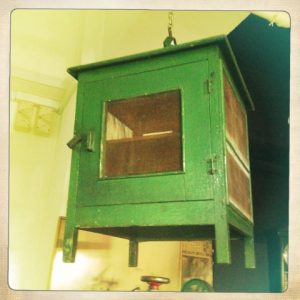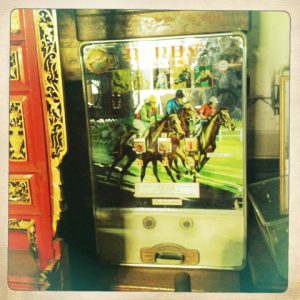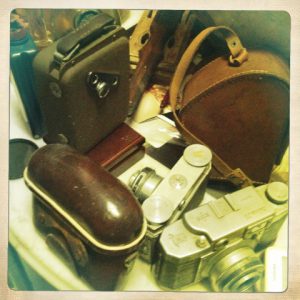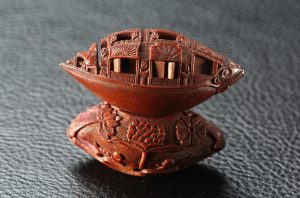The heritage prop collector (& other items)
A photographer shares his love of all things old, antiques and seed-carvings.
BY: Eleanor Yap
Advertising photographer Charlie Lim, 65, is a rebel with a cause. He has gone beyond usual photography into oil painting and light-painting, a photographic technique where exposures are made by moving a hand-held light source while taking a long exposure photograph. Beyond him being known for all this, he also sidelines as a heritage prop collector, buying old items not only for his own expanding personal antique collection but also to use in his photography sessions and to rent out to photographers and events companies.
Ageless Online talks with Charlie about how his unique prop collection got started and how he decides what makes it into his collection of old things:
When did you start buying old items as your props and also for your antique collection? It is interesting that some of these items were from your own past and your family didn’t keep them and now you are buying them.
I started buying old items as my props when I came out to do advertising photography in the early ’90s. It’s because they can be used as props for my food shoots. And for my antique collection, I started in the early ’70s, a few years after I started working. Firstly, my buying habit must have been influenced by my mum. Secondly, I asked myself what is the value of money in 20 years’ time. To me, the value of money never stays the same with inflation and all that.
There is only one item that was from my own past, which my mum gave away, and I bought a similar one to replace it and that is a stone grinder. Sad that my mum gave away the sentimental grinder, which I used it to help my grandmother during festive periods. She would make homemade kueh and I would help her.
You also have kept some of your mother’s items. Can you share more about some of them? How many old items (those used as props) do you have? What is the oldest item? What is the most expensive item you spent?
Oh, on my mother’s items, I only inherited from her some tiny wine/liquor bottles, which were given free during the Chinese New Year promotion. But I did take over an old antique plate, which was bought by my late father … even before I was born.
In the ’90s, I created a 12-month calendar for a SAFE departmental store. I used old items like an iron, fan, radio, weighing machine, lamp, etc. I probably have more than 250 items as shooting props including travel props. My oldest item must be ink bottle and feather pen, which is from around the 19th century. The most expensive prop item I spent during those days must be a stone seal carving at S$2,300.
You use these items in your props in photographs as well as when people want to rent them. Can you share some of the scenarios when people wanted them and where some of them have been used?
Events companies, photo studios and direct clients do rent from me for theme events/set-in photo shoots and/or decorations. For specific events, for example a Shanghai scene, Safari expedition or even “Singapore in the ’60s”.
Where do you buy some of these items? How often do you buy these items? What are some items you are still on the lookout for? How do you avoid getting conned?
In the early days, I usually bought from flea markets in Singapore and countries like Thailand, Indonesia, Malaysia, Philippines and China. Only occasionally, do I buy from antique shops as they would then be pricier. In the ’90s, for a period of time, I went to flea markets for about three to four times a month. I don’t have much to look out for at this stage. In fact, I stopped buying for a long time, but I bought a little safe box and an ice-cream container from Indonesia in 2014.
Prop items are easy to identify if it is an imitation, not like antiques, especially porcelain products where you really need to be a real expert. Old props, in today’s context are still not easy to copy; the only one that is being imitated a lot is the gramophone, however, you need to look for one that needs to cranked.
Can you share two interesting stories relating to your buying of old items?
Sometime in the ’80s, I reserved one standing gramophone (size is up to waist level). On that day I didn’t have enough money to pay on the spot. Within two hours, the boss of the shop called up to say that another customer wanted to buy it over and asked me how much I wanted to let it go for. On the next day, one more customer called, who wanted to buy it over and turn it into a bar counter!
Another interesting story relating to buying the old items is that the shop owners that I often dealt with are now friends.
Can you explain how you distinguish items that you consider as your props vs those that are antiques? You would sell your antiques but would you also sell your props?
Almost all of my props are less then 100 years old. And anything that is more than 100 years old you can consider them as antiques. Basically, props are things that you can use in daily life. Where as, antiques are more for display purposes and serve as an investment. I am not selling the prop section, as I hope to sell my company one day and the props are part of that entity. Yes, I am already starting to sell part of my antiques especially my seed carving collections.
What are five items (those used as props) that you consider most valuable (not necessarily price-wise, could also be unique) and why?
My five most valuable items are: Gramophone, microphone, standing camera, food cage and telephone. These items are unique, and they are no longer in production.
Do you feel you are hoarding, but with a purpose? How big is your space where you have these items? I understand they are labelled and in respective areas, can you explain?
Yes, I am hoarding, which I didn’t realise it until I had a room full of items! I am turning our studio into a heritage museum and gallery with a total space of almost 2,000 sq ft.
They are not labelled, but are placed at certain sections of the studio so that it’s easy to identify them. There are just too many to label and takes up too much time to do it as I have to do this personally.
What would your only son do with these items if something happens to you?
My son and I have not been talking for the past seven years, and we have never been close. He gets nothing from me if I am gone. All will be willed.
I understand you also collect seeds, how many do you have? You even have a small ship made out of seeds.
Yes, I also collect seed-carvings from peach, walnut, olive, coconut to other unknown seeds. In my collection, I have more than 2,000 different seed-carvings, which I started collecting in 1971. Today, I must have the biggest seed collection in the world, mentioned by Chinese seed carvers. In the ’60s and ’70s, Chinese in China were not allowed to collect any antiques or decorative items for themselves even though they had the money to buy. This is during the Cultural Revolution era.
There are more than 500 different designs from my collection and I have more than 14 different designs of the boat alone.
Why seeds?
Good question. The reasons I picked seeds:
(1) All seeds or fruit pods are natural materials, which can be detected if they are fake.
(2) They are made of very hard material, even tougher than wood and no two seeds are the same.
(3) Olive seeds are good for blood circulation and ward evil spirits.
(4) It takes a very creative and experienced carver to carve on olive seeds or even on walnut. I heard that it takes up to a year of practice just to handle different knives. So handwork is involved and patience is much needed.
(5) Since handwork is involved, it also means labour cost, which to me never stays consistent.
(6) In 1971, my first olive seed-carving costs me only S$2.50, which was the boat with six windows that can be opened or closed, and an anchor in the front of the boat! All are made out of seeds. Today, I can’t buy the same design and the market value is now more than S$2,500.
Are you still going to continue collecting more? Are you planning to sell them?
I have almost stopped buying for the last 10 years as prices are high and besides, they have started to use machines to help them to carve, which means the value is only half of mine. The price and design has got to be super-attractive or unusual for me to buy.
Yes, I am planning to sell them and fly the world several times (joking). I am hoping that someone can buy my main lot for a private “seed-carving” museum in Singapore or China since I have so many items that could fill up a 1,000-sq ft showroom. Besides my carvings are not found in today’s market as great masters carved them in the early days when they had plenty of time to do a good job.
As a collector, what advice would you give to other collectors interesting in buying old items?
As a collector for almost 40 years, I would recommend that other collectors interested in buying old items should look out for:
• Items that are no longer in production.
• Items that are in good working condition, if possible.
• Anything that has have carved or written with Chinese character on it (not machine-cut).
• Go out to places like Europe (UK especially) or US to look for old stuff.






0 Comments